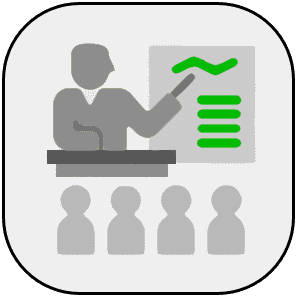|
 The
Capability Maturity Model of CM-CEI is an organizational model that describes
5 evolutionary stages (levels) in which the processes in an organization are
managed. The
Capability Maturity Model of CM-CEI is an organizational model that describes
5 evolutionary stages (levels) in which the processes in an organization are
managed.
The thought behind the Capability Maturity Model, originally developed
for software development, is that an organization should be able to absorb
and carry its software applications. The model also provides specific steps
and activities that help to bring an organization from one level to the next.
The 5 stages of the Capability Maturity Model
- Initial (processes are ad-hoc, chaotic, or actually few processes
are defined)
- Repeatable (basic processes are established and there is a level
of discipline to stick to these processes)
- Defined (all processes are defined, documented, standardized
and integrated into each other)
- Managed (processes are measured by collecting detailed data on
the processes and their quality)
- Optimizing (continuous process improvement is adopted and in
place by quantitative feedback and from piloting new ideas and technologies)
Software Maturity model
The CMM describes the principles and practices underlying software process
maturity. It is intended to help software organizations improve the maturity
of their software processes in terms of an evolutionary path. This path goes
from ad hoc, chaotic processes, towards mature, disciplined software processes.
The focus is on identifying key process areas and the exemplary practices
that may comprise a disciplined software process. The maturity framework provided
by CMM establishes a context in which:
- Practices can be repeated. If you don't repeat an activity, there is
no reason to improve it. There are policies, procedures and practices, that
force the organization to implementing and performing consistently.
- Best practices can be rapidly transferred across groups. Practices are
defined sufficiently to allow for transfer across project boundaries, thus
providing some standardization for the organization.
- Variations in performing best practices are reduced. Quantitative objectives
are established for tasks; and measures are established, taken, and maintained
to form a base-line from which an assessment is possible.
- Practices are being continuously improved to enhance capability (optimizing).
The Capability Maturity Model is useful not only for software development,
but also for describing evolutionary levels of organizations in general and
in order to describe the level of Management that an organization has realized
or wants to aim for.
The Structure of the Capability Maturity Model
- Maturity Levels - A layered framework providing a progression
to the discipline, which is needed to achieve continuous improvement. It
is important to state here that an organization develops the ability to
assess the impact of a new practice, technology, or tool on their activity.
Hence it is not a matter of adopting these, rather it is a matter of determining
how innovative efforts influence existing practices. This empowers projects,
teams, and organizations by giving them the foundation to support reasoned
choice.)
- Key Process Areas - Key process area (KPA) identifies a cluster
of related activities that, when performed collectively, achieve a set of
goals considered important.
- Goals - The goals of a key process area summarize the states
that must exist for that key process area. The states must be implemented
in an effective and lasting way. The extent to which the goals have been
accomplished is an indicator of how much capability the organization has
established at that maturity level. The goals signify the scope, boundaries,
and intent of each key process area.
- Common Features - Common features include practices that implement
and institutionalize a key process area. These five types of common features
include: Commitment to Perform, Ability to Perform, Activities Performed,
Measurement and Analysis, and Verifying Implementation.
- Key Practices - The key practices describe the elements of infrastructure
and practice that contribute most effectively to the implementation and
institutionalization of the key process areas.
Process Definition Criteria
Process Definition Criteria are the set of process elements that must be
included in a software process description for it to be usable by the people
performing the process. To establish the criteria you are asking the question
- "What software process information do I need to document?"
Such process elements are:
- Purpose - why is a process performed?
- Input - what work products are used?
- Output - what work products are produced?
- Role - who (or what) performs the activities?
- Activity - what is done?
- Entry criteria - when (under what circumstances) can processes
begin?
- Exit criteria - when (under what circumstances) can processes
be considered complete?
- Procedure - how are activities implemented?
- Reviews and audits performed.
- Work products that are to be managed and controlled (or placed
under configuration management).
- Measurements to be made.
- Training.
- Tools.
Book: James R.
Persse - Implementing the Capability Maturity Model
Book: Mary Beth
Chrissis - CMMI : Guidelines for Process Integration and Product Improvement
|
Forum discussions about Capability Maturity Management.

|
CMMI Level 5 Should be Made Simpler
CMMI level 5 should be made easier without too much thrust on usage of mathematical analysis. Ultimately the business needs to be captured....
 4 |
|
|
|
Courses about Capability Maturity Management.

Beginners Course
|

Advanced Course
|

Course for Experts
|
|
|
|
The best, top-rated topics about Capability Maturity Management. Here you will find the most valuable ideas and practical suggestions.
|
🥇
|
Capability Maturity Model > CMMI
This article needs to be updated. It is currently focused on CMM-SW that has been replaced in 2002 by a more comprehensive model (CMMI)(Capability Maturity Model Integration) in terms of scope and dep...
 17  1 comments
|
|
|
|
Advanced insights about Capability Maturity Management. Here you will find professional advices by experts.

Consultancy Tips
|

Teaching Tips
|

Practical Implementation Tips
|
|
|

|
Weaknesses of the CMM Model Implementing Process Improvements
- CMM does not describe HOW to create an effective software development organization.
- CMM compliance is not a guarant...
|

|
Process and Enterprise Maturity Model Alternative to CMM, Process-Based Transformation Efforts
Although most executives are aware that a redesign of business processes can lead to extraordinary improvements in cost,...
|

|
The CMMI Model Process Improvement
The Capability Maturity Model Integration (CMMI) is the successor of the Capability Maturity Model (CMM). A new version ...
|

|
IDEAL Model Alternate Process Improvement Model
Originally, the IDEAL model was a life-cycle model for software process improvement based upon the Capability Maturity M...
|

|
Origins of CMM Teaching Process Improvement, History
In the mid 1980s, the United States Air Force funded a study at the Software Engineering Institute (SEI) of the Carnegie...
|
|
|
|
Various sources of information regarding Capability Maturity Management. Here you will find powerpoints, videos, news, etc. to use in your own lectures and workshops.

|
Capability Maturity Model Integration (CMMI) In-depth Capability Maturity Model Integration, CMMI Models, CMM Models
This presentation is about the Capability Maturity Model Integration and includes the following sections:
0. Part 1: ...
|

|
Introduction Into CMM and P-CMM CMM, P-CMM, Software Management, Human Capital Development
Introduction into the Capability Maturity Model, including the following sections:
1. Outline
2. Why CMM matters
3. H...
|

|
Capability Lifecycles Maturity Management
Article by Constance E. Helfat and Margaret A. Peteraf introduces the concept of the capability lifecycle (CLC), which a...
|

|
CMMI Diagram Capability Maturity Management
Download and edit this 12manage PowerPoint graphic for limited personal, educational and business use.
Republishing in ...
|

|
CMM in Software Process Improvement Process Improvement, Capability Maturity Management
Extensive presentation about CMM in software processes, by T. Schouten (2010). The presentation first explains the quali...
|
|
|
|
Useful tools regarding Capability Maturity Management.

News
|

Videos
|

Presentations
|
| |

Books
|

Academic
|

More
|
|
|
|
Compare with the Capability Maturity Model:
People CMM
| OPM3 |
Balanced Scorecard |
Baldrige Award |
EFQM |
Change Approaches
| Organizational Learning
| Kaizen
Return to Management Hub: Change & Organization | Human
Resources | Knowledge & Intangibles | Supply Chain & Quality
More Management Methods, Models and Theory
|
|
|













